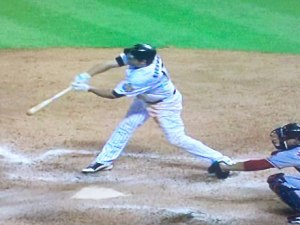
HE STILL WENT!!!!
One of the greatest things about baseball is that, while eras, governments, and people change, the game stays relatively constant. If a man from 1903 walked into a modern baseball stadium, he might be confused by the flashing scoreboards, casual attire of the fans, and the big silver birds flying swiftly and surely over his head, but he would understand completely that which went on between the white lines. The game can often serve as connective tissue between us and the past.
However, that doesn’t mean the game can’t ever change. Often, the sport needs to utilize new technology, whether it be to make the game safer (think helmets) or to keep baseball thriving even as the marketplace changes rapidly (by embracing first radio, then television, and now, the series of tubes commonly known as the internet.)
However, in baseball, there is often great fear of change – this sport, more than any other, gets so wrapped up in its own tradition it fails to embrace new ideas for the sake of preserving that tradition. Remember, it took until 1970 for the league to make helmets mandatory, 50 years after the death of Ray Chapman.
The same can be said about the relationship between baseball and instant replay. When baseball came of age, the only medium that could transmit information immediately was the telegraph. The first televised MLB game, broadcast on the experimental station W2XBS and called by the immortal Red Barber, had only two cameras; one was behind home plate and the other trained on Barber. There were no monitors, so Barber had to guess which camera was on and where it was pointed.
Needless to say, the technology has come a long way, baby. Each MLB game now has over a dozen cameras capturing every square inch of the stadium, all in crystal clear high definition. We have K-Zones giving us the precise location relative to strike zone of every pitch, and infrared cameras that can pinpoint exactly where and when a ball makes contact with a glove or bat (one of the more ridiculous additions Fox has made to their baseball coverage). So why should everyone in the ballpark be able to utilize this technology except those who are paid to get the calls right?
Regarding the format of the replay system, the one MLB seems intent on putting in place next year is patently ridiculous. The goal of a replay system should be to get every call right, not to allow blatantly wrong calls to stand because managers cannot afford to waste a challenge on them.
My system would work like this; have a 5th umpire in the press box, sitting next to an HDTV, and give him a headset to communicate with the crew chief. If a play is close, have the 5th umpire take a look at it – give him a maximum of a minute and a half to make his decision, so as not to slow down the pace of the game. Make balls and strikes non-reviewable: everything else is fair game.
There is an argument that instant replay robs baseball of some of its human element – that replay eliminates some of the frailties of man that make baseball so great. And it’s true; with instant replay, we would miss out on some of the great moments in baseball history, like Don Denkinger calling Jorge Orta safe in the 1985 World Series, or Jim Joyce robbing Armando Gallaraga of a well-deserved perfect game. However, I believe the human element lies in the battle between hitter and pitcher, and between fielder and runner. No missed calls should affect the outcomes of those battles, not when they don’t have to.
Baseball is great precisely because while everything else changes, baseball doesn’t. But utilizing the available technology, in this case, would not ruin the sport – it would only serve to make it stronger.
